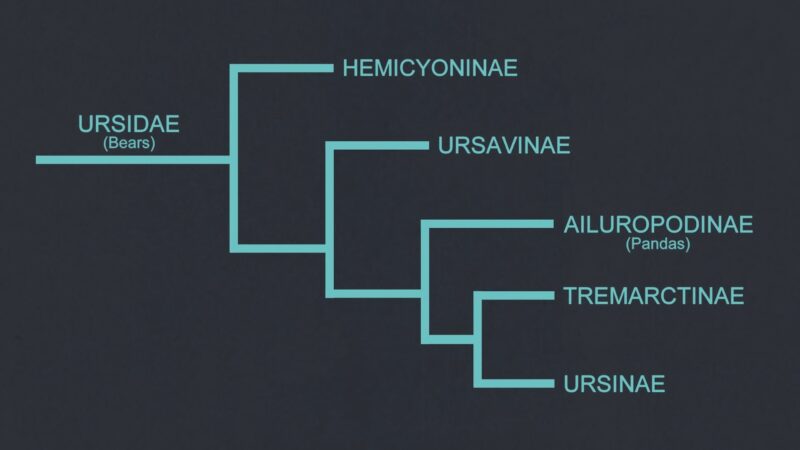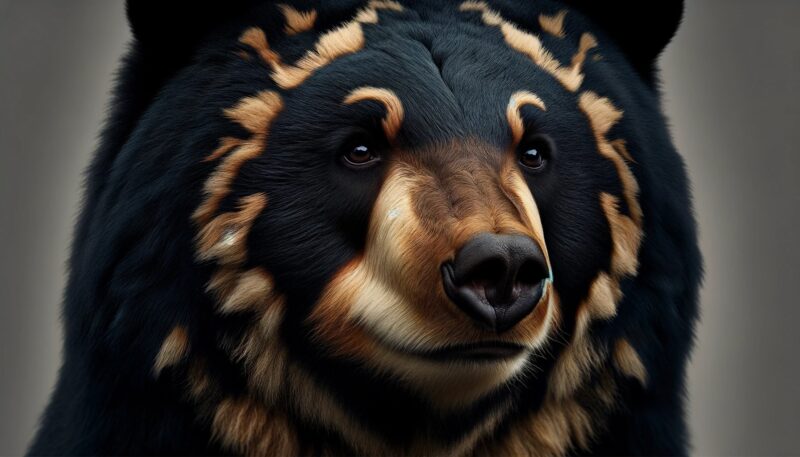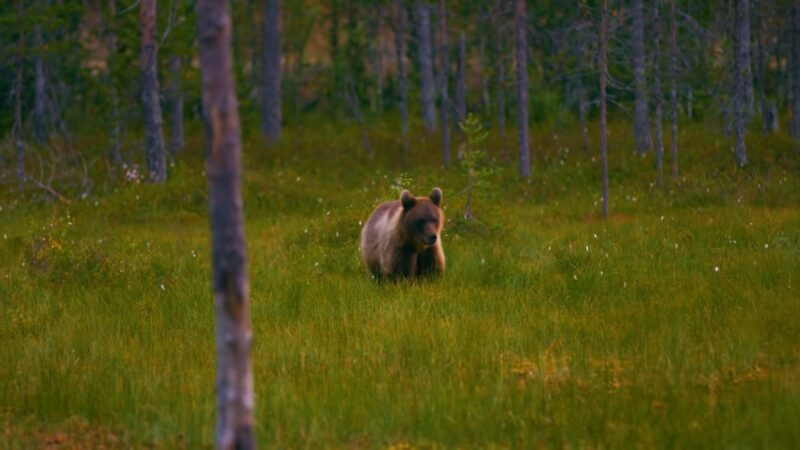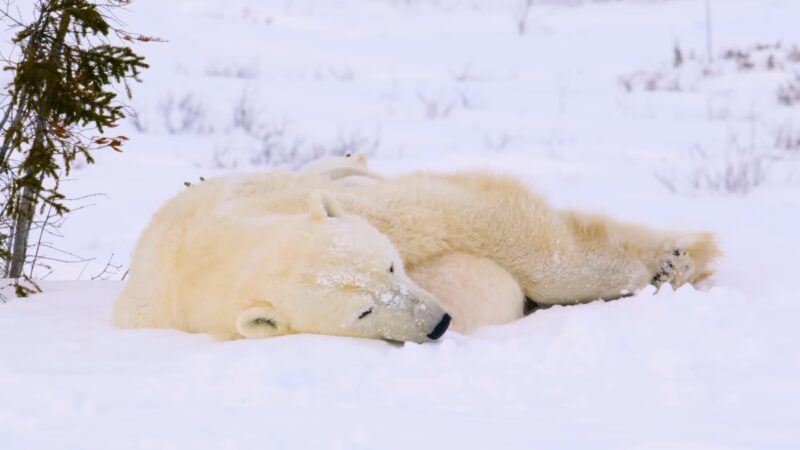Bears are fascinating animals that have changed a lot over time. They started as small creatures living in trees and have become the big, diverse types of bears we see today.
In this article, we’ll look at how these animals have evolved, from their early days in the forests to the different places they live in now.
Key Takeaway
- The earliest known bear, Ursavus elmensis, was small and tree-dwelling.
- Bears evolved from small, arboreal mammals to the diverse species we see today.
- The Pleistocene epoch was crucial for the emergence of the eight bear species we recognize now.
- Human activity, including habitat destruction and climate change, has significantly influenced bear evolution.
- The polar bear is almost entirely carnivorous, while the giant panda is almost exclusively herbivorous.
The Origins
The bear’s evolutionary journey began about 30 million years ago. The earliest known bear, Ursavus elmensis, was a small, tree-dwelling creature, quite different from the large, ground-dwelling bears we know.
This animal, roughly the size of a small dog, was an omnivore, setting the stage for the dietary flexibility seen in modern bears. Fossils of Ursavus elmensis show adaptations for climbing, suggesting a life spent mostly in trees.
This arboreal lifestyle likely provided safety and access to a variety of food sources. Over time, as their size increased, these early bears began exploring more terrestrial habitats, marking the beginning of a significant evolutionary transformation.
Transition to the Ground
As time progressed, bears evolved to become larger and more adapted to ground living. The appearance of Hemicyon, a genus that lived around 20 to 5 million years ago, marks this significant shift.
These bear dogs, as they’re often called, were adept runners, indicating a lifestyle that involved chasing prey, unlike the ambush tactics of big cats. The evolution to a more ground-oriented life coincided with changes in their limb structure, allowing for better locomotion on land.
These adaptations enabled Hemicyon to exploit new food sources and habitats, paving the way for the diverse bear species we see today. This period also saw a diversification in bear diets, ranging from hypercarnivorous to omnivorous feeding habits, reflecting their adaptive flexibility.
Diversification into Species

The Pleistocene epoch, starting about 2.5 million years ago, was crucial for bear evolution. This era saw the emergence of the eight species we recognize today:
| Species | Habitat | Physical Characteristics | Diet | Special Adaptations |
|---|---|---|---|---|
| Brown Bear (Ursus arctos) | North America to Eurasia | Thick fur, hulking physique | Omnivorous: Fish, mammals, fruits, insects | Adapted to cold habitats |
| American Black Bear (Ursus americanus) | Forests across North America | Shorter claws for climbing | Omnivorous: Berries, nuts, small mammals | Climbing skills for foraging and protection |
| Polar Bear (Ursus maritimus) | Arctic regions | White fur, large, flat feet with deep pads | Carnivorous: Primarily seals | Adapted for swimming, keen sense of smell |
| Asian Black Bear (Ursus thibetanus) | Mountainous areas in Asia | Longer fur, mane around the neck | Omnivorous: Varied mountain diet | Excellent climbing skills, adapted to cooler habitats |
| Andean Bear (Tremarctos ornatus) | Andes Mountains, South America | Smaller size, distinctive facial markings | Omnivorous: Fruits, bamboo, small animals | Tree-climbing skills for rugged, forested habitats |
| Panda Bear (Ailuropoda melanoleuca) | Mountainous regions in China | Thumb-like appendage for bamboo | Specialized: Bamboo | Adapted gut microbiome, solitary lifestyle |
| Sun Bear (Helarctos malayanus) | Tropical forests of Southeast Asia | Small size, long tongue | Omnivorous: Honey, insects | Agility in trees and ground |
| Sloth Bear (Melursus ursinus) | Indian subcontinent | Shaggy coat | Specialized: Termites, ants | Nocturnal, powerful sucking lips |
Adaptations for Survival

For example, the polar bear, with its white fur and fat-rich diet, is perfectly adapted to Arctic life. In contrast, the panda bear’s unique dietary preference for bamboo indicates a significant dietary specialization.
Polar Bears: Their body fat, up to 4 inches thick, provides both insulation and buoyancy in the water. Their fur is not only white to blend with the snow but also hollow, trapping air for additional insulation. Polar bears have a reduced metabolic rate, an adaptation that allows them to conserve energy in their harsh environment.
Panda Bears: Pandas have strong jaws and molars to crush tough bamboo, a crucial adaptation for their specialized diet. Their solitary nature helps reduce competition for the limited bamboo resources available in their habitat. Pandas have a slower reproductive rate, which is thought to be an adaptation to their energy-conserving lifestyle.
The Role of Climate Change
Climate fluctuations have played a pivotal role in bear evolution. The ice ages of the Pleistocene, for instance, forced many species to adapt to colder environments.
The polar bear is a prime example, having likely evolved from a brown bear ancestor that adapted to the icy conditions of the Arctic.
- Adaptations to Cold: Besides polar bears, other bear species also adapted to colder climates. Brown bears developed thicker fur and a layer of fat to survive in colder regions. Some species, like the American black bear, adapted by hibernating during winter to conserve energy and survive on stored fat.
- Migration and Range Expansion: Climate change often led to shifts in bear habitats, pushing some species to migrate to new areas. As glaciers retreated, brown bears expanded their range, adapting to various ecosystems. This migration and expansion contributed to the diversification and adaptation of bear species.
- Extinction and Survival: While some bear species adapted successfully to climate changes, others, like the cave bear, could not cope and became extinct. This demonstrates the impact of environmental changes on bear evolution and the survival of species. Modern climate change continues to pose challenges for bear species, particularly for those like polar bears, whose habitats are rapidly changing.
Human Impact
Human activity has significantly influenced bear evolution in recent times. Habitat destruction, climate change, and hunting have pressured bear populations, leading to adaptations and sometimes, tragic extinctions.
The cave bear (Ursus spelaeus), for instance, went extinct about 24,000 years ago, likely due to a combination of climate change and human hunting. In more recent times, the expansion of human settlements and agriculture has resulted in substantial loss of natural habitats for bears, fragmenting populations and limiting their access to food and mates.
This fragmentation often forces bears into closer contact with humans, leading to conflicts that frequently end badly for the bears. Additionally, climate change is altering ecosystems at a rapid pace, challenging bears to adapt quickly to changes in food availability, particularly for species like the polar bear, which relies on sea ice to hunt seals.
FAQs

Did bear species ever migrate between continents?
Yes, bear species did migrate between continents. For instance, it’s believed that ancestors of the American black bear migrated to North America from Asia via the Bering land bridge during the Ice Ages.
Are there any bear species that have evolved to be strictly carnivorous or herbivorous?
While most bear species are omnivorous, the polar bear is almost entirely carnivorous, primarily feeding on seals. Conversely, the giant panda is almost exclusively herbivorous, eating primarily bamboo.
How have bears’ sensory abilities evolved?
Bear sensory abilities have evolved to suit their diverse habitats and lifestyles. For example, polar bears have an acute sense of smell, crucial for detecting seals over great distances. In contrast, giant pandas have a heightened sense of touch, aided by their pseudo-thumb, to handle bamboo.
Are there any known extinct bear species besides the cave bear?
Yes, there are several extinct bear species besides the cave bear, such as the short-faced bear (Arctodus simus), which was one of the largest terrestrial mammalian carnivores that ever lived.
How has global warming affected polar bears specifically?
Global warming has significantly impacted polar bears, primarily through the loss of their sea ice habitat. This loss leads to reduced access to their primary prey, seals, resulting in lower birth rates, poorer cub survival, and a decline in overall population health.
Summary
The way bears have evolved is an interesting story of how they have adapted to survive. They began as small tree-dwellers and have become the various large species we know today.
Their evolution shows us how animals change over time and remind us of the importance of protecting wildlife as our world changes.
Related Posts:
- How do Animals Communicate Through Sound? - Sound of Nature
- What Are Pizzly Bears And Grolar Bears? - Hefty Hybrids!
- What Biome Do Grizzly Bears Live In? Into the Great…
- Can Bears Climb Trees? - From Ground to Treetop
- Do Bears Have Tails? - Find Out the Truth Here
- Can Bears Swim? - Everything You Need to Know








